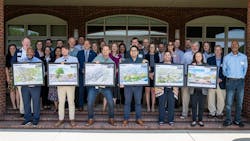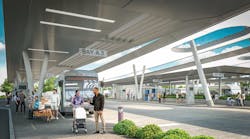NCDOT publishes study to help communities plan development along future passenger rail service line
The North Carolina Department of Transportation (NCDOT) has provided communities along the S-Line rail corridor in central North Carolina with plans and strategies to prepare for Transit Oriented Development (TOD) based off of a study released this week by NCDOT.
The study explores the development along the S-Line rail corridor, which is a key missing link between Raleigh and Richmond, Va. The S-Line will better connect the Southeast to Washington D.C., and places further north.
The TOD project will create compact development in the area with a mix of housing, office space, retail, civic spaces and neighborhood amenities near a mobility hub that brings together in one location public transit, ride-sharing services and other modes of travel.
“The study is the result of a close partnership between NCDOT and the S-Line communities to understand how passenger rail can help each community achieve their goals,” says Julie White, NCDOT deputy secretary for multimodal transportation. “From more affordable housing to more walkable vibrant town centers, the study provides guidance to the towns for how to make the most of the future passenger rail opportunity.”
Through the TOD study, communities along the S-Line would leverage the future benefits of rail to plan for improved mobility and access, increased housing, downtown vibrancy, higher quality of life and economic vitality.
The S-Line TOD study evaluated market conditions, affordable housing considerations, multimodal transportation opportunities and regulatory conditions in several central North Carolina communities. The study proposes transportation improvements that would meet a vision responsive to each communities’ needs.
Two NCDOT divisions -- Integrated Mobility and Rail -- partnered with seven N.C. communities – Sanford, Apex, Raleigh, Wake Forest, Youngsville, Franklinton, Henderson and Norlina – to complete the study. The process evaluated previous transportation planning efforts, the potential for real estate market demand and affordable housing considerations. Other planning factors included economic development, multimodal connectivity, environmental sustainability and quality of life.
Each participating community received a “playbook” with recommendations to continue planning and development efforts. The playbook included sites to consider for transportation-focused development, a timeline for executing goals and projects needed to complete multimodal transportation initiatives.
The next step of the plan involves mobility hub site assessments and design, made possible by a RAISE grant the U.S. Department of Transportation awarded in August 2022. Mobility hubs serve as a focal point for connectivity and development in each community – bringing together rail service with local transportation modes, private development, and other public land uses.
The outcomes of the TOD study underscore NCDOT’s goal to develop a robust multimodal system that provides safe and efficient access and mobility for all North Carolinians.



